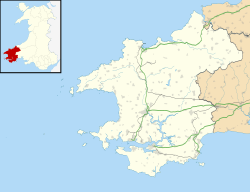History and description
The church is dedicated to St Dogfael, and was built between 1864 and 1865. The architect was Robert Jewell Withers and the patron Sir Thomas Lloyd. [1] Lloyd, a landowner and Member of Parliament for Cardiganshire, claimed descent from the ancient Lords of Cemaes [2] and spent a considerable amount of his inheritance in pursuit of a peerage and in the construction of a number of buildings on his estate in a Gothic Revival style, including his home, Bronwydd Castle, the court house at Felindre Farchog, the restoration of the genuinely medieval castle at Newport and the little church of St Dogfael. [a] [5]
The church is small and simple. Lloyd, Orbach and Scourfield, in their Pembrokeshire volume of the Buildings of Wales Pevsner, describe it as "an object lesson in High Victorian geometry and minimal extraneous detail". It is built of sandstone, with Bath stone dressings and a slate roof. [5] Constructed on the site of an earlier church, [1] the north doorway may a genuine Norman piece, or a later medieval one, from the original structure. [5] The church is a Grade II listed building [5] and, having been declared redundant, is now in the care of the charity, the Friends of Friendless Churches. [1]
This page is based on this
Wikipedia article Text is available under the
CC BY-SA 4.0 license; additional terms may apply.
Images, videos and audio are available under their respective licenses.

